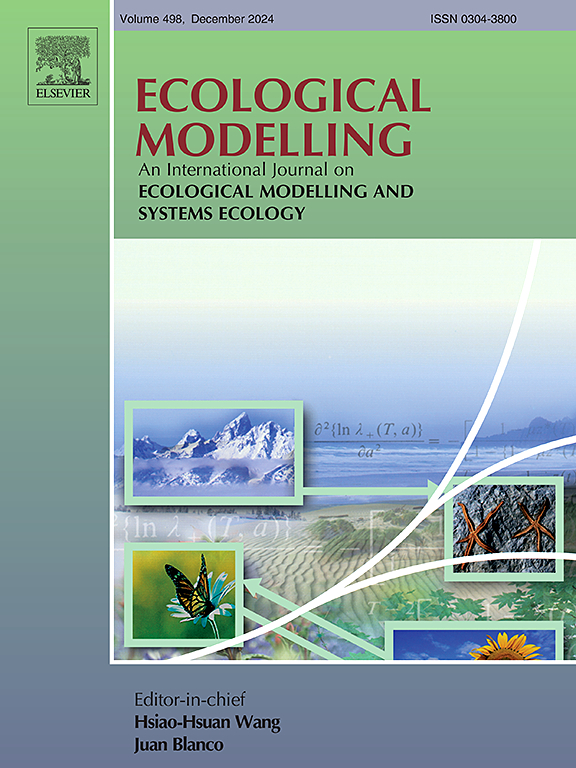气候变化情景下地中海森林生态系统肉桂疫霉相关衰退风险预测
IF 2.6
3区 环境科学与生态学
Q2 ECOLOGY
引用次数: 0
摘要
肉桂线虫是一种威胁地中海盆地常绿橡树和甜栗树生态系统的入侵病原菌。了解这种森林病原体的分布仍然不确定,因为在症状变得明显之前难以准确评估它们的存在,这使得预测其发生具有挑战性。在这项研究中,我们调查了肉桂在法国、意大利、葡萄牙和西班牙的分布和适宜性,实施了一个混合模型(即相关和基于过程的),并对总共527个记录的事件进行了验证。我们使用了一个包含两类非生物环境变量的相关模型:地形和地形。此外,我们采用了考虑关键气候因子和高时间分辨率地球观测数据的3种基于过程的模式。具体来说,我们估计了极端最低和最高温度下的存活率,以及生长季节的生长风险,作为病原体严重程度的代表。这四种模型的结合产生了对病原体分布的更可靠的估计。我们的研究结果表明,目前在酸性和营养含量较低的土壤中,肉桂藻存在的可能性较高。在基于过程的模型中,春季生长风险模型在整个研究区域中表现出最显著的变化,随着时间的推移预期会增加。然而,从长远来看,肉桂树在夏季的存活预计将限制其在伊比利亚半岛某些地区的存在,特别是在高排放情景下。有趣的是,研究结果还表明,在某些地区,肉桂树的生长有潜在的增强,同时也注意到这些地区夏季存活率的下降。这些观察结果强调了病原体分布的复杂性和动态性,并强调了考虑多种因素以全面了解其潜在影响的重要性。本文章由计算机程序翻译,如有差异,请以英文原文为准。

Forecasting the risk of Phytophthora cinnamomi related-decline in Mediterranean forest ecosystems under climate change scenarios
P. cinnamomi is an invasive pathogen which threatens the evergreen oak and sweet chestnut ecosystems in the Mediterranean Basin. Understanding the distribution of this forest pathogen remains uncertain due to the challenges in accurately assessing their presence until symptoms become apparent, making it challenging to anticipate its occurrence. In this study, we investigated the distribution and suitability of P. cinnamomi in France, Italy, Portugal, and Spain implementing a hybrid model (i.e. correlative and process-based) with the validation of a total of 527 recorded occurrences. We used a correlative model incorporating two categories of abiotic environmental variables: edaphic and topographic. Additionally, we utilized three process-based models accounting for key climate factors and considering earth observation data with high temporal resolution. Specifically, we estimated survival under extreme minimum and maximum temperatures, as well as growth risk during the growing season as a proxy of the severity of the pathogen. The combination of these four models yielded a more reliable estimation of the pathogen's distribution. Our findings revealed that higher probability of P. cinnamomi presence currently stem from acidic and less nutrient rich soils. Among the process-based models, the spring growth risk model displayed the most significant variation across the study area, with an expected increase over time. Nevertheless, the survival of P. cinnamomi during summer is predicted to limit its presence in certain areas of the Iberian Peninsula in the long term, particularly under higher emissions scenarios. Interestingly, the results also indicate a potential enhancement in the growth of P. cinnamomi in some regions, while simultaneously noting a decrease in summer survival in those same areas. These observations underscore the complexity and dynamic nature of pathogen distribution and emphasize the importance of considering multiple factors to gain a comprehensive understanding of its potential impact.
求助全文
通过发布文献求助,成功后即可免费获取论文全文。
去求助
来源期刊

Ecological Modelling
环境科学-生态学
CiteScore
5.60
自引率
6.50%
发文量
259
审稿时长
69 days
期刊介绍:
The journal is concerned with the use of mathematical models and systems analysis for the description of ecological processes and for the sustainable management of resources. Human activity and well-being are dependent on and integrated with the functioning of ecosystems and the services they provide. We aim to understand these basic ecosystem functions using mathematical and conceptual modelling, systems analysis, thermodynamics, computer simulations, and ecological theory. This leads to a preference for process-based models embedded in theory with explicit causative agents as opposed to strictly statistical or correlative descriptions. These modelling methods can be applied to a wide spectrum of issues ranging from basic ecology to human ecology to socio-ecological systems. The journal welcomes research articles, short communications, review articles, letters to the editor, book reviews, and other communications. The journal also supports the activities of the [International Society of Ecological Modelling (ISEM)](http://www.isemna.org/).
 求助内容:
求助内容: 应助结果提醒方式:
应助结果提醒方式:


